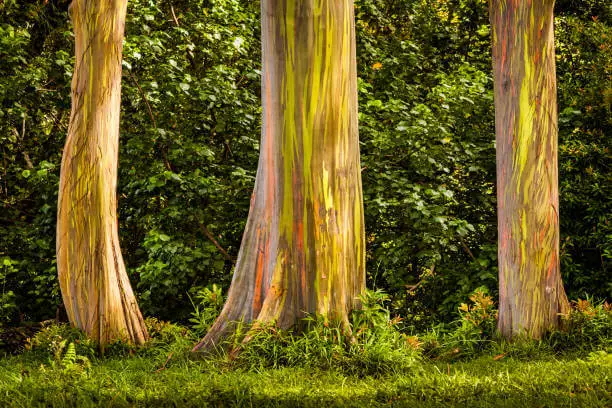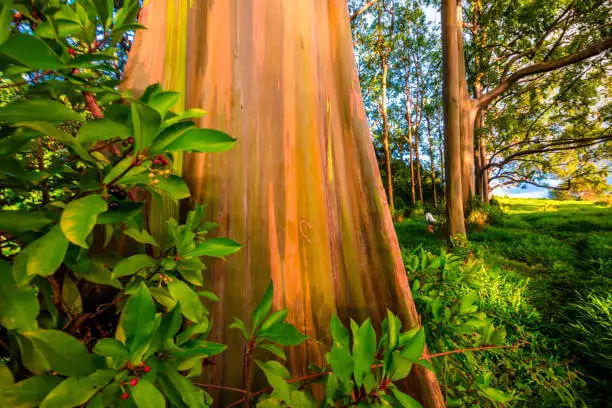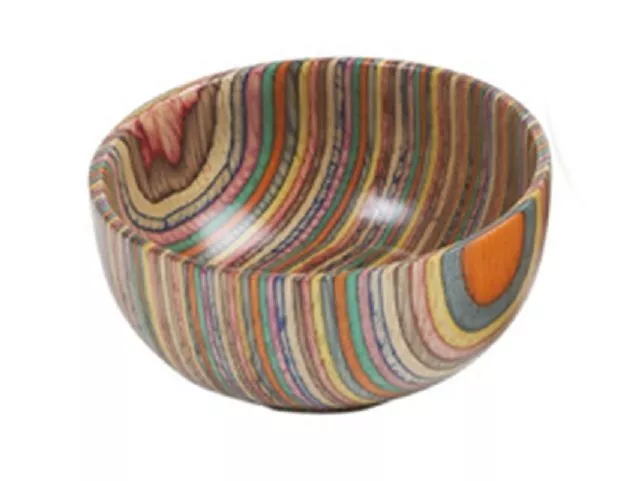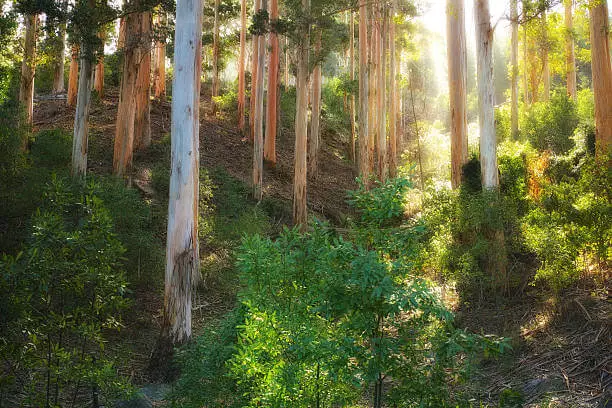What is Rainbow eucalyptus wood best used for?
Rainbow eucalyptus is not a rare, legally protected variety despite the lush surface colors and unique appearance.
Instead, it is in high demand and limited for industrial needs. Fresh material is quite inconsistent, requires drying in natural conditions, prone to cracking.
Due to the ability of the tree to grow quickly, the area of forestry plantations is quite actively renewed. Extensive plantations are allocated for it. Trees reach 20 years of industrial maturity.

Rainbow eucalyptus wood for furniture
Is it possible to make rainbow eucalyptus wood good for furniture? The wood structure is fibrous, even though it is difficult to handle manually, but the surface is well impregnated with paint, holds varnish, sticks together, and abrades.
It is characteristic that among them, there is practically none dull or inconspicuous. Rainbow trees look fantastic – as if painted ‘under the rainbow’ with bright watercolors from bottom to top of the trunks.
You might think that the rainbow tree’s appearance makes it suitable as furniture, but not. The eucalyptus finished wood is very dense. In hardness, it can compete with oak.
But rainbow eucalyptus is easy to crack, and it is not a good choice for woodworking. Also, read other types of wood for outdoor furniture.
What are the primary uses of the rainbow eucalyptus tree?
Use this wood to make a white paper of excellent quality technical cotton. Rainbow eucalyptus is an ideal raw material to turn. Souvenirs, dishes, photo frames, carved jewelry are made from it.
In the Philippines, multicolored tree is mainly grown for paper production. The spectacular appearance of trees and rapid growth allows them to landscape streets and create picturesque landscapes.
A strong root system, such as a pump that draws excess water from the soil, is useful for wetlands.
The feature of rainbow eucalyptus wood
Rainbow eucalyptus (eucalyptus deglupta) belongs to the scaly representatives of the genus Myrtle family. This tree has unique features, which differ from closely related species.
The main feature is a bright, shimmering with many shades of all colors, bark.

Rainbow eucalyptus bark
The main feature of the rainbow look, for which the plant got its name – shades of bark.
It is quite dense, smooth, has a multilayer structure, peels unevenly during the tree’s life, and falls off with narrow longitudinal plates.
The bark cannot develop the full-color range outside a tropical zone.
The bark of a rainbow eucalyptus changes color depending on its age. Fresh plates are light green at first. After a while, under the influence of air and sun, they darken and become emerald.
Then the bark successively changes color to dark silver, blue, purple, orange, red, raspberry, and burgundy.
The plates are brownish brown before exfoliating. They separate from the trunk, exposing new light green surfaces.
Since the update is uneven, there are layers of the cortex of different ages at the same time, forming a palette of bright transition shades of the entire color spectrum.
The rainbow tree characteristic
It is resistant to adverse weather conditions, damage and is easily restored by root shoots, even after destroying a part of the tribe
At a young age, rainbow eucalyptus is very delicate, round, bright green. Transition is more elongated and thickened. Adult leaves are narrow, linear, with pointed tips, silver-gray hue.
Rainbow eucalyptus tree facts
The plant loves moisture, is slightly acidic or neutral fertile, has loose soil, and is moderately resistant to cold.
Most adult specimens reach 40-50 m. There are also taller ones – up to 75 m. At a young age, rainbow eucalyptus overgrows, reaching up to 2.5 m per year.
Initially, the trees remain quite thin: a giant of 10 meters should not be more than 40 cm thick. They start to sound broad after 20 years.
The flowers of the rainbow eucalyptus are inconspicuous: small, white, collected in small thyroid inflorescences: fruit – round light green boxes with many small seeds.
Unlike other eucalyptus tree varieties, rainbow eucalyptus does not contain any glands in the green that produce essential oil and does not have a characteristic pungent aroma.

Rainbow eucalyptus tree origin, and where did it grow?
Rainbow eucalyptus (Eucalyptus deglupta) is the only species found in the natural environment of the Northern Hemisphere. The Philippines is considered the birthplace of wood.
The breed was successfully introduced to Indonesia, Malaysia, China, Brazil, Florida, Cuba, Fiji, Sri Lanka, Honduras, and Puerto Rico.
In the US, rainbow eucalyptus grows in the frost-free climate of Hawaii and the southern parts of California, Texas, and Florida. In the continental US, the tree only grows to heights of 100 to 125 feet.
It is increasingly being planted in warmer states in America because of its beautiful bark, but it is ‘at home’ in Indonesia, Papua New Guinea, and the Philippines.
Rainbow Eucalyptus as an art of nature
There are dozens of different Eucalyptus species, but none as unique as the Eucalyptus deglupta. A tree with every rainbow color is like an abstract painting, a palette of shades, an experiment of mother nature.
No painter can compete with that, and in reality, it is always more beautiful; the colors arise because the tree keeps dropping pieces of its bark, causing other colors to emerge.
The tree is not the same for a month, living ever-changing art. However, not everyone gets the chance to see the beauty produced by the Rainbow Eucalyptus Tree, whose colors change when its layers of bark come off.

Rainbow eucalyptus bowl
Rainbow wooden bowls may appear to be made of rainbow eucalyptus, but actually, rainbow bowls are made of different types of colored wood, all of which are stacked and glued together.
When rainbow eucalyptus wood turns into a bowl, it doesn’t look as beautiful as the rainbow eucalyptus tree.
Like any other wood, the rainbow colors only appear on the bark and do not go inside the heartwood.
See the image above, what the rainbow bowls look like, and the real rainbow eucalyptus wooden bowl.
Is it possible to make rainbow eucalyptus wood flooring
Unfortunately, rainbow eucalyptus is not suitable for wood floors, as we explained before by its characteristics?
The color is only on the wood bark, and let imagine what your wooden floor looks like if you have a wooden floor with rainbow color. Is it going to be amazing, right?
The only common eucalyptus tree can be made for wood flooring. Read other varieties of eucalyptus wood, and you can read more about eucalyptus wood flooring.
In summary, some common uses of rainbow eucalyptus:
1. It is widely used in the wood pulp industry for preparing wood pulp
2. It is also used as an ornamental plant for its aesthetic quality. It is used to decorate houses, parks, fields, gardens, etc.
3. Because of its aromatic fragrance, it is also used in the perfume industry.
4. The oil is used for medicinal purposes. Studies have shown that it can fight bacteria and relieve pain.

Eucalyptus tree and its Varieties
Here is a selection of eucalyptuses prized for their ornamental properties, size or hardiness, and uses.
- Eucalyptus camaldulensis: Redgum or river gum, it is also used in essential oil.
- Citriodora of Eucalyptus: Lemon eucalyptus gives off a lemon scent but is mainly used for its anti-inflammatory properties.
- Eucalyptus deglupta : Rainbow eucalyptus, it has a beautiful and very decorative trunk, it offers reflections in blue, orange, and red tones.
- Eucalyptus globulus: Bluegum tree, widely cultivated and used to strengthen the immune system.
- Eucalyptus gunnii: The one used in the perfumery, but also adapts very well to temperate climates.
- Eucalyptus radiata: Eucalyptus radiates, is used for its essential oils, and grows mainly in Australia.
- Eucalyptus regnans: Royal eucalyptus, the size can reach 100 m high!
- Eucalyptus smithii: Smith’s Eucalyptus. It is valued for the gentleness of its essential oil and is an excellent disinfectant.
- Eucalyptus niphophila: Eucalyptus with lanceolate leaves, more rustic with resistance to cold and frost down to -20°
